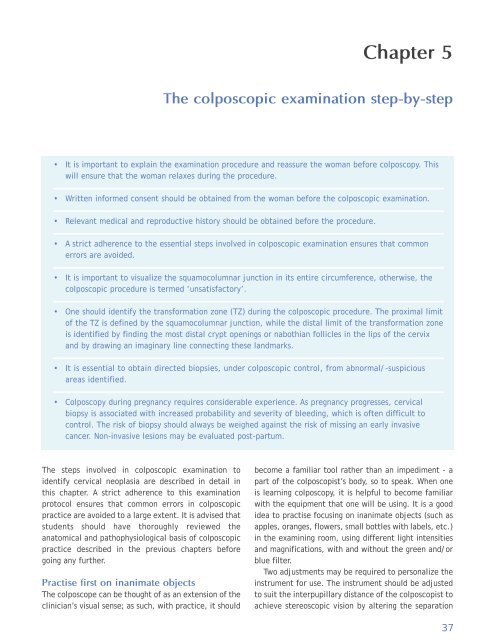Colposcopy and Treatment of Cervical Intraepithelial Neoplasia - RHO
Colposcopy and Treatment of Cervical Intraepithelial Neoplasia - RHO
Colposcopy and Treatment of Cervical Intraepithelial Neoplasia - RHO
Create successful ePaper yourself
Turn your PDF publications into a flip-book with our unique Google optimized e-Paper software.
Chapter 5<br />
The colposcopic examination step-by-step<br />
• It is important to explain the examination procedure <strong>and</strong> reassure the woman before colposcopy. This<br />
will ensure that the woman relaxes during the procedure.<br />
• Written informed consent should be obtained from the woman before the colposcopic examination.<br />
• Relevant medical <strong>and</strong> reproductive history should be obtained before the procedure.<br />
• A strict adherence to the essential steps involved in colposcopic examination ensures that common<br />
errors are avoided.<br />
• It is important to visualize the squamocolumnar junction in its entire circumference, otherwise, the<br />
colposcopic procedure is termed ‘unsatisfactory’.<br />
• One should identify the transformation zone (TZ) during the colposcopic procedure. The proximal limit<br />
<strong>of</strong> the TZ is defined by the squamocolumnar junction, while the distal limit <strong>of</strong> the transformation zone<br />
is identified by finding the most distal crypt openings or nabothian follicles in the lips <strong>of</strong> the cervix<br />
<strong>and</strong> by drawing an imaginary line connecting these l<strong>and</strong>marks.<br />
• It is essential to obtain directed biopsies, under colposcopic control, from abnormal/-suspicious<br />
areas identified.<br />
• <strong>Colposcopy</strong> during pregnancy requires considerable experience. As pregnancy progresses, cervical<br />
biopsy is associated with increased probability <strong>and</strong> severity <strong>of</strong> bleeding, which is <strong>of</strong>ten difficult to<br />
control. The risk <strong>of</strong> biopsy should always be weighed against the risk <strong>of</strong> missing an early invasive<br />
cancer. Non-invasive lesions may be evaluated post-partum.<br />
The steps involved in colposcopic examination to<br />
identify cervical neoplasia are described in detail in<br />
this chapter. A strict adherence to this examination<br />
protocol ensures that common errors in colposcopic<br />
practice are avoided to a large extent. It is advised that<br />
students should have thoroughly reviewed the<br />
anatomical <strong>and</strong> pathophysiological basis <strong>of</strong> colposcopic<br />
practice described in the previous chapters before<br />
going any further.<br />
Practise first on inanimate objects<br />
The colposcope can be thought <strong>of</strong> as an extension <strong>of</strong> the<br />
clinician’s visual sense; as such, with practice, it should<br />
become a familiar tool rather than an impediment - a<br />
part <strong>of</strong> the colposcopist’s body, so to speak. When one<br />
is learning colposcopy, it is helpful to become familiar<br />
with the equipment that one will be using. It is a good<br />
idea to practise focusing on inanimate objects (such as<br />
apples, oranges, flowers, small bottles with labels, etc.)<br />
in the examining room, using different light intensities<br />
<strong>and</strong> magnifications, with <strong>and</strong> without the green <strong>and</strong>/or<br />
blue filter.<br />
Two adjustments may be required to personalize the<br />
instrument for use. The instrument should be adjusted<br />
to suit the interpupillary distance <strong>of</strong> the colposcopist to<br />
achieve stereoscopic vision by altering the separation<br />
37
















